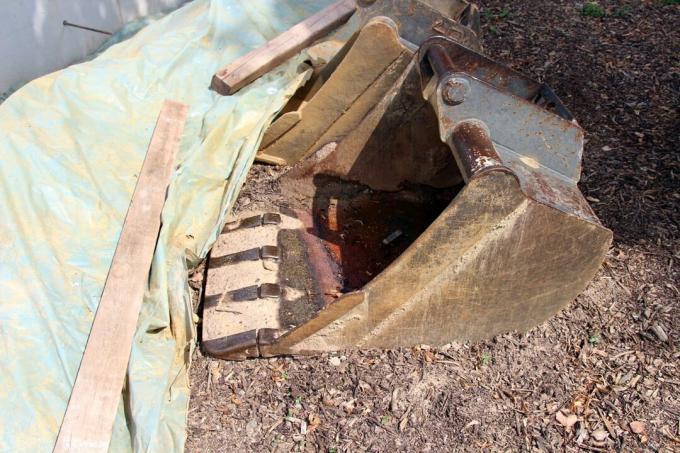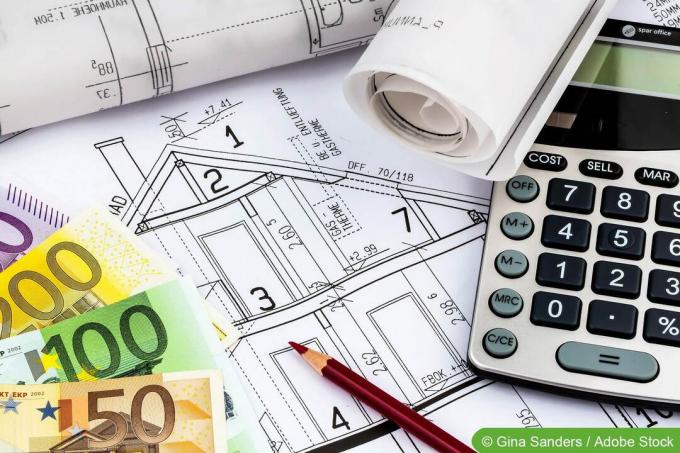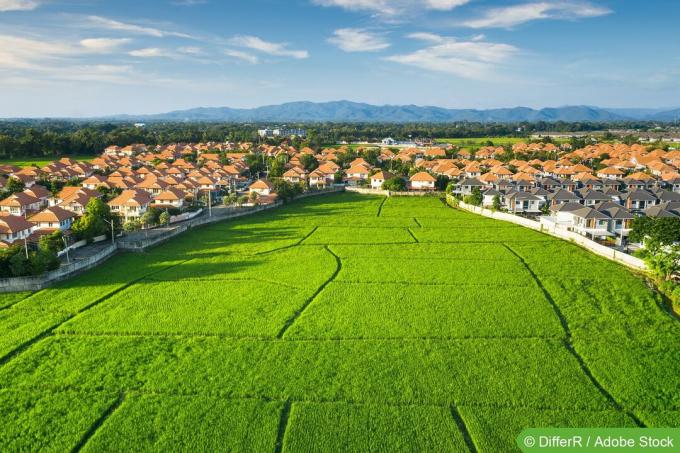

Table of contents
- Excavation definition
- Acceptance and disposal types
- Recycling center / landfill
- big bag
- container disposal
- truck disposal
- Free disposal
- self exploitation
- find buyers
- excavation calculation
If excavated earth collects when building a house, landscaping or building a pool, many ask themselves the question of disposal and the possible costs. All the details about it can be found below.
Excavation definition
The term "excavation" includes soil masses of sand, clay, loam and topsoil. Grass soils also count if the turf has been removed. If it consists of plant remains, stones or root systems, it is not a classic excavation in the legal sense. Only small amounts of the materials mentioned are permitted and must therefore be disposed of as excavated earth. A soil excavation that is mixed with chemical foreign substances, such as those caused by large quantities of fallen plaster paint or asbestos deposits that can get into the ground after refurbishment/renovation work are considered to be contaminated or hazardous waste.
Tip:
House and garden owners are fully responsible for determining the soil. If there is knowledge or the assumption that there could be "forbidden" foreign materials in it, a soil report is always on the safe side.
Acceptance and disposal types
There are several ways to get rid of excavated soil. If companies are involved and/or the provision of utensils/transport containers is required, this entails costs.

Recycling center / landfill
Excavated earth can be accepted at many recycling depots/landfills. This type of disposal is one of the cheapest options because the excavated soil is only stored. Below are the costs and other details worth knowing:
- Prices for acceptance: between three and five euros per ton
- Usually acceptance only up to one cubic meter of excavated soil
- A cubic meter of weight: between 900 and 1,000 kilograms, depending on the degree of humidity
- Price excluding collection and transport costs
big bag
When it comes to disposing of soil, so-called big bags also offer a cost-effective solution. They are available in different sizes and are made of a very durable organic material. The following is the most important information about this:
- Available in well-stocked hardware stores, numerous recycling companies or on the Internet
- Purchase price: depending on size and provider between 3 and 7 euros
- Maximum capacity: two cubic meters
- No free disposal via municipal garbage disposal
- Disposal is subject to a charge via municipal or private companies
- Pickup possible in almost every major city
- Collection prices: depending on weight and region between 90 and 300 euros
container disposal
If you decide to dispose of it in a container, you have the option of collecting it and picking it up "cleanly" by the provider.
- Possible container sizes: 3, 5, 7 or 10 cubic meters
- Optional self-filling or by container service
- Additional costs for external filling per 10 cubic meters: between 200 and 250 euros
- Prices: from about 100 euros per cubic meter (prices vary greatly depending on the provider - price comparison is worthwhile)
- Advantage: service life between one day and 14 days
truck disposal
If masses of excavated earth occur regularly, as is often the case when building a house, for example, the removal and the It makes sense to have it disposed of by a freight forwarder/truck, because this is how the largest quantities can be transported away are.
- Capacity: up to 26 cubic meters (tipper)
- Cost: if you fill it up yourself, between 800 and 1,000 euros
- Possibly plus rental of mini excavator: between 180 and 300 EUR
- Costs for external filling per 10 cubic meters: between 200 and 250 euros
- Additional transport costs to and from the landfill: between 180 and 250 euros
- Additional landfill storage costs: between 300 and 500 euros
- Disadvantage: Collection of the excavated earth - when the filling capacity is reached, extensive space is required
A notice:
All prices are for rough orientation and do not represent binding prices.
Free disposal
If you want to save the money for the fee-based disposal of excavated earth, there are free methods to choose from:
self exploitation
The best free option is to use the excavated earth yourself. Especially when building a house, soil is often required for the garden after completion. But even after excavating the ground for a pool or garden pond, topsoil is the main problem. It is precisely then that further use should be considered. Until then, the excavated soil can be stored somewhere on the property where it will not disturb.

find buyers
If you have no use for excavation yourself, you should look for buyers for the free version. Up to ten cubic meters are often accepted. Topsoil, in particular, is in high demand. The customer then bears the transport costs. The following possible customers and how they can be reached:
- Ask house builders or in new development areas
- Gardening and Landscaping Company
- address acquaintances and friends
- Place advertisements in sales portals
- Submit offer in local newspaper
A notice:
Excavated earth is not arable land and must therefore not be "disposed of" there either. For this reason, acceptance by farmers is usually only possible in exceptional cases.
excavation calculation
Many homeowners find it difficult to calculate the excavation. Just because earth was excavated for a 50 cubic meter water tank, for example, does not automatically result in 50 cubic meters of excavated soil. In addition to the length, width and depth of the area, the so-called movement space also plays a role in the calculation. Below are some calculation examples to compare the quantities with the costs and disposal options.
- Sinking of rigid hollow bodies (e.g. underground tanks or pools): soil excavation twice as large, of which 2/3 remains
- basement excavation: Example interior size 10 x 10 meters plus 2.50 meters foundation depth - for wall thickness, insulation and Add 2 meters of drainage = 12 x 12 x 2.5 gives a 364 cubic meter excavation left over remains
 Home editorial office
Home editorial office
Learn more about construction planning

Costs of a preliminary building inquiry using the example of an EFH
A preliminary building inquiry provides more planning security when building a house, can save money and effort and is therefore often useful. When making the request, builders should pay attention to a few points in order to avoid delays and problems. We provide information about the costs of a preliminary building application using the example of a single-family house (EFH).

Calculate base area number (GRZ) correctly
If you want to build on a property in this country, you will inevitably encounter the area number (GRZ). This is a value for determining the permissible development area of the property. We will explain how to correctly calculate the number of base areas.

Calculate floor area ratio (GFZ) correctly
BMZ, GRZ, GFZ: If you want to build, you will come across a large number of terms and key figures that you should definitely know. In this article, we will tell you what the floor area ratio is all about and how to calculate it correctly.

Shell land: what is that? | definition
If you want to fulfill your dream of owning your own home, you will stumble across confusing terms when looking for a suitable plot of land. Read here what raw building land is all about and why you can save money when purchasing it.

Farm expectation land: what is it? | definition
When looking for an inexpensive piece of land, the term “expected building land” often comes up. Many interested parties cannot really imagine anything. We will explain to you what building land is and how it differs from classic building land.

Barrier-free: Requirements for apartments suitable for the disabled
Steps with ramps Barrier-free homes must meet certain requirements in order to be suitable for people with a physical or mental disability. It depends on several factors that combine to make an apartment suitable for the disabled.

